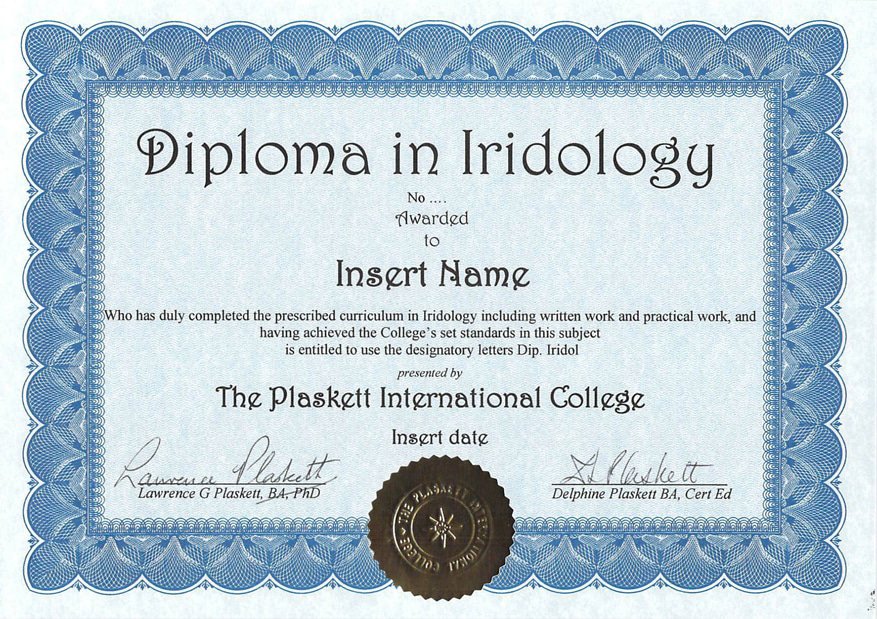Learn Iridology
with the
Plaskett International College
Enrol now to learn how Iridology
can make a huge contribution to any complementary therapeutic practice.
What is Iridology?
Iridology is the art of iris analysis. The iris is connected to the brain via the hypothalamus and can give naturopathic read outs on tissue conditions in various parts of the body.
With training and practice, it is possible to read signs indicative of biochemical, emotional and environmental influences that are hard to determine by other means. We can thus interpret health (and even aspects of personality) by close examination of the eyes, using suitable illumination and a magnifying glass.
The close relationship between naturopathic iridology as a diagnostic tool and nutritional therapy and other naturopathic disciplines continues and grows closer. Now Iridology can make a huge contribution to complementary therapeutic practice and enhanced by our wonderful digital collection of eye photographs, the learning process with the Plaskett International College is a profound and exciting one.
We teach Iridology quite separately from other topics and anyone who possesses, or expects to possess, a practitioner's qualification in any therapeutic discipline, may join the course. If this is of interest, please read on ...
The course covers the nature of iris observation, the intestinal areas, the iris map, the chronic and acute, the intestinal ring, stomach ring and nerve wreath, the constitution, respiratory system, lacunae, open lesions, inherent weaknesses, the organs of elimination, other organs, special signs, complete diagnosis of a subject. The treatment of the topic follows the principles of Bernard Jensen in the USA.
Once the basics have been learnt, the course teachings then extend considerably by bringing in the work of Dorothy Hall and of Dr Josef Deck, both of which are the subject of a special presentation during the course. The published insights of Farida Davidson and Harri Wolf, while not separately presented, also influence the presentation of the course material. Both the Australian School, (Dorothy Hall) and the German School, (Dr Deck/Harri Wolf), offer an added dimension to the study and interpretation of the constitution.
The study focuses upon the different personality aspects, which show up in different constitutional types. Dorothy Hall gives insights into what contributes to various different types of personality and their emotional and mental responses and their pre-dispositions to health or disease. Different sorts of people can have different priorities, preferences and imperatives built into their very nature from or before birth, sometimes determining the course of their entire lives and their attitudes to the world and to other people.
The course teaches an understanding of these types and facilitates an empathy between patient and practitioner. It shows how people of the differing constitutional types are likely to go out of balance either mentally or emotionally and how their vulnerability to various physical ailments varies.
The German School offers a very exciting and precise approach to the constitutional types, which is really quite different, but no less helpful. It highlights variations in the susceptibility to diseases of different organs and systems.
It is a prime purpose of this course, not only to teach these differing positions, but also to demonstrate how it is that all three of these major schools of Iridology embody different aspects of the truth, how each is individually valuable and how a full and deep understanding of the meaning of 'constitution' can be gained through a sympathetic synthesis of the contributions from all three of these schools.
JOIN OUR LIST FOR DETAILS
OF ANY CURRENT OFFERS ON THIS COURSE
ALREADY HAVE A DISCOUNT CODE?
What Happens Next?
- Upon submission of your enrolment form you will receive your login details via email so that you can start your studies with us without delay.
- Within 24 hours you will receive a welcome email from your Course Tutor. You are assigned a Course Tutor to provide email and/or telephone/Skype support for the duration of your study period.
- The course is presented via an online study platform which you will have access to 24/7. You will also have the option to purchase a hard copy of the course folder if this study method is preferred.
- You will have 1 year to complete your course and upon successful completion of your assignments and two case studies, you will receive a Diploma in Iridology.

Here’s what people have to say about the course
Dr Ezequiel Lafontaine
Iridologist, Puerto Rico
"I LOVE IRIDOLOGY. I have over 30 iridology books, Italian, French, German, Spanish and English, plus over 4,000 photos from my own practice. I took this course for a refresher course and found the material was second to none."
Mrs D. Moothy
Nutritional Therapist, Mauritius
“The distance learning courses have given me the opportunity to pursue my dreams through a program that was not only flexible and convenient for my schedule, but was also challenging and rewarding. I thoroughly enjoyed the readings and the assignments but most importantly, I enjoyed being able to do things at my pace. I must say that the most exciting and challenging course was the Iridology Diploma, and I am happy that I was able to do well in all the courses.”
Emma Rubio
Health Coach, Spain
"As a Health Coach I decided to pursue my studies with the Plaskett College to become a Nutritional Therapist. For that, I am also studying Iridology. I am happy to have a tutor to answer my doubts and I like the flexibility that the College offers me. I love the subject of Iridology and the way it is explained, I also like having some videos of Dr Plaskett teaching Iridology as I admire him."
Breakdown of the Course Sections
In total there are 9 sections comprising of text, videos and iris images to study. You can view further details of each by accessing the PDF of the course syllabus here
1
General Practice and the Gastro-Intestinal areas.
2
Features of the Fibres Outside the Autonomic Nerve Wreath.
3
Special Signs
4
The Constitutions in Relation to Pesonality Type and Disease Dispostion.
5
More about the White Signs.
6
Colours in the Iris and other Special Signs.
7
The Constitution and Signs According to the German School.
8
Further Details of the Iris Chart and Brown Eyes
9
Consultations and Practice Management
Welcome from the Course Author,
Dr Lawrence Plaskett
I want to welcome you most warmly to the study of Iridology. Students of our course have taken their knowledge out into the world of practice and they have been able to see more penetratingly into the health of their patients. They have seen many truths about causes and effects in health and disease - that is what allows you to understand those extra things that make you into an even better healer.
I think you are going to find this the most intriguing and absorbing study and, certainly, that is my sincere hope. As you precede, much of what you learn will amaze you and inspire wonder at the ways of the human body and mind. As you tread this very special road, I pass on to you the words that Bernard Jensen gave me years ago when I was his student, inscribed upon the inside cover of his book:
“Seek the Higher Values in Life”.

How Iridology can help Practitioners
Did you know that some iris features are so very plain that you can see them with the naked eye in ordinary social contact? You can see from two or three feet away in many cases that the person has a toxic digestive system (a strong wide dark ring around the pupil margin). You can often tell that the person has an overactive stomach (a narrow bright white ring very close to the pupil). You can tell when the skin is overlaid with toxins so that the skin's function in excreting toxins from the body is jeopardised (very narrow dark ring around the iris margin). You can tell in some people (rather advanced cases) that they suffer badly from sodium and potassium imbalance and have placed themselves at potential risk from cholesterol accumulation (the so-called sodium ring, a white or off-white cloudy deposit, usually fairly thick, around the iris margin).
Another example is the ring of spots or 'tophi' represented by the lymphatic rosary. Its mere presence tells one that there is sluggishness in the lymphatic system. When these tophi are darkly pigmented, the situation gives rise to concern for the possible generation of lymphatic illness.
Using the precise positioning of iris reflex areas contained on the iris chart, one may distinguish many key points of diagnosis. Areas of stress and tension can be pinpointed by identifying 'stress rings' or 'nerve rings'. Past injuries and adhesions show themselves as contortions of the normally regular and even iris fibres. You can answer questions like:-
Is it the pancreas or the liver that is responsible for the trouble? Is the patient's hypertension caused by a defect of or toxic deposits in the particular brain area that is geared to control blood pressure? One of Jensen's rather dramatic illustrations is of the iris of a man who has just been shot. It shows the precise areas of tissue damage within the body and the response is very fast.
The number of potential examples is almost without limit. The above may suffice to show the types of things that Iridology can do for practitioners. We hope it will help you decide to study Iridology with the Plaskett International College.
Iridology Diploma Course
Access to all course material upon enrolment and payment
£495